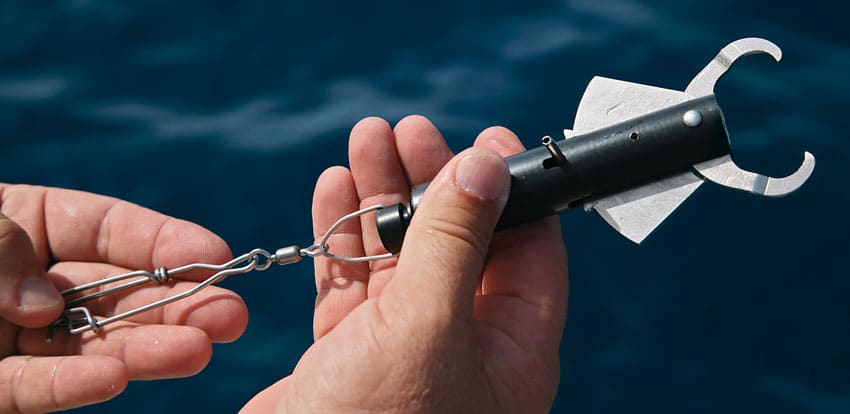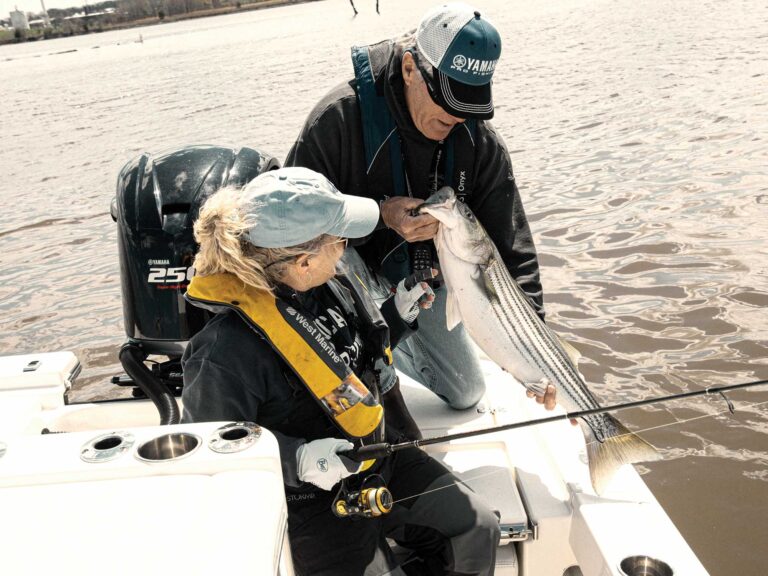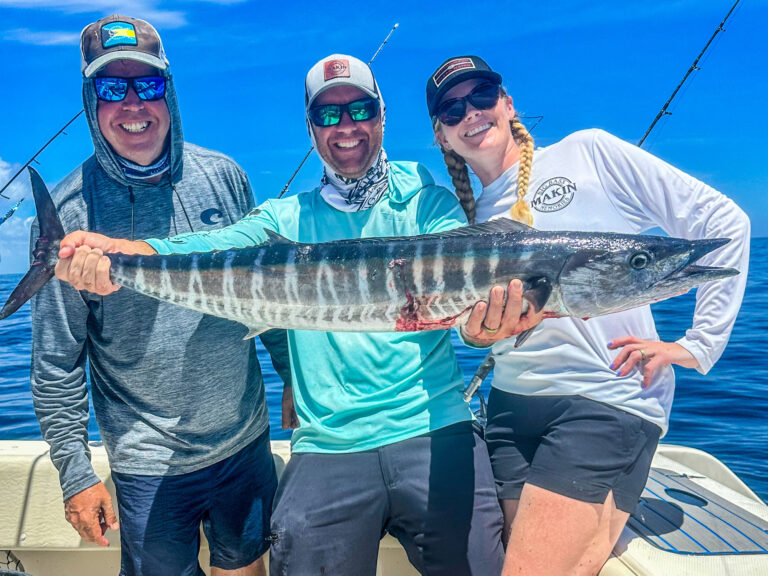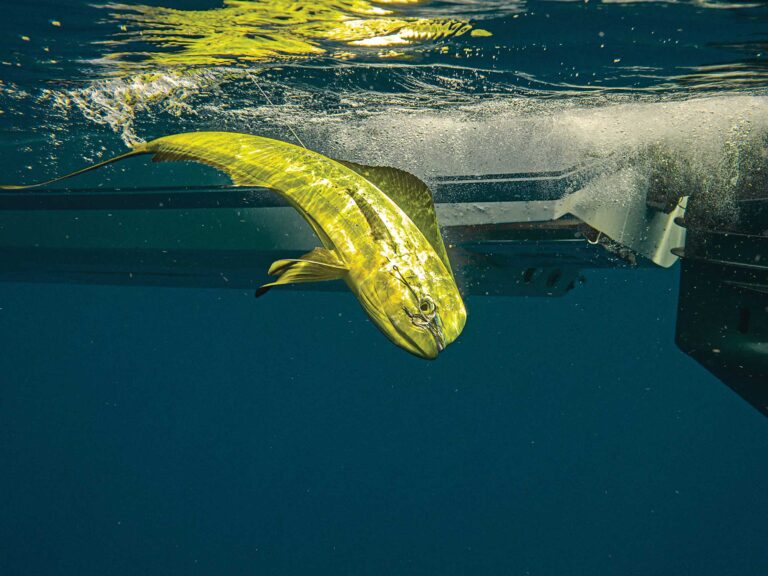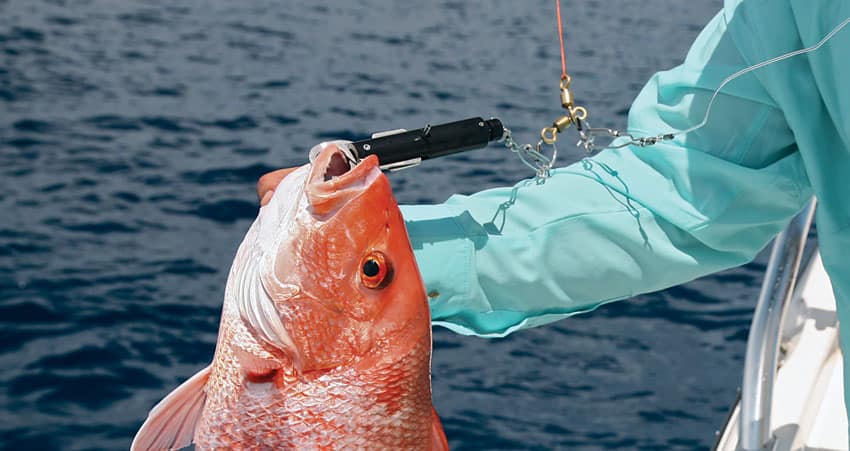
The anticipation built as we closed in on a bottom spot some 84 miles out in the Gulf of Mexico off Sarasota, Florida. It wasn’t just the flutter-jigging action we hoped to find that fueled our excitement, but the opportunity to test a brand-new release device for bottomfish, one which could render venting obsolete. Little did I know just how easy and effective this device would prove on the red snapper and undersize red grouper we were about to catch.
Releasing undersize, unwanted or closed-season bottomfish is a daunting task, and for good reason. When benthic species such as groupers, snappers, sea bass and tilefish are brought up from depths of 50 feet and more, their swim bladders expand due to the reduction of pressure, which compresses internal gasses, as the fish ascend in the water column. Expanding gasses enlarge swim bladders and can in extreme cases force them to rupture. Damage from pressure change is known as barotrauma and results in fish that are bloated, primarily around the pectoral fins. Their stomachs may protrude from their mouths, and intestines from their anuses. So unless a released fish is properly vented — that is, has its swim bladder punctured with a needle — it won’t be able to return to its lair. It will die or become forage for a larger predator.
With venting, a hollow needle is inserted into the pectoral region of a bloated fish to penetrate the swim bladder and release the gasses, which allows the fish to swim back to the bottom. While venting has proven to be successful, it is not without controversy. Many people, including some from the scientific community, think venting actually harms fish and isn’t as effective as we’d like to think in preserving a fish’s life. Of course, there’s the other side, which says that without venting, fish have zero chance of survival. Many think that if venting is done properly and no internal organs are punctured, fish survive just fine and the slight puncture wound from the needle or venting tool heals.
The SeaQualizer Revolution
The device I tried off Sarasota is the SeaQualizer, a tool for safely and efficiently releasing bottomfish back to their environment. It was developed as a team effort by Jeffrey Liederman, big-game angler and proprietor of Capt. Harry’s Fishing Supply, in Miami; Patrick Brown, a student working on his master’s degree in marine affairs and policy at the University of Miami; and Ryan Brown, a Florida International University graduate with a degree in civil engineering.
The trio felt the regulatory environment was ripe for an easier, quicker, safer and more effective way to release fish compared to venting. In addition to delivering a higher survival rate among released bottomfish, the men hope to show the governmental agencies that regulate recreational fishing that extreme rules and closures are not necessary to protect particular species. For example, consider zones entirely closed to fishing to protect a single species. Provided this device ensures the safe release of protected species caught incidentally, it’s feasible that such a zone could remain open to fishing for other species. This tool could have a major impact on recreational angling regulations.
How It Works
The SeaQualizer works by recompressing fish. That is, it takes a fish back down through the water column, where the increasing pressure on the swim bladder compresses the internal gasses so the fish can swim about as it did prior to being captured. It should be noted that recompression is already used in many regions to successfully release bottomfish, with techniques that involve sending fish down in weighted baskets or to the bottom on weights. Yet the SeaQualizer offers additional advantages: ease of operation and the precision of freeing a fish at one of three preset depths. It is not necessary to lower a fish clear to the bottom before it is released.
The SeaQualizer has a locking grip that fastens to a fish’s jaw much like a scale or release device. It also contains an internal pressure chamber and a three-setting adjustment knob at its opposite end. This adjustment controls the pressure at which the jaws open to release the fish. It can be set to open at 50, 100 or 150 feet.
To send the SeaQualizer, a 5-pound weight and a fish into the depths, I used a heavy conventional rod paired with a conventional low-speed reel filled with heavy line, as suggested. My Penn Senator 114H2 has a 2.9:1 gear ratio, which made it easy to crank up the heavy lead after the release. The 100-pound-test braid coming off the rod tip was tied to a three-way swivel, and each of the two remaining eyes of the swivel had a small monofilament loop affixed. The 5-pound weight was tied to a short length of heavy monofilament with a longline clip at the opposite end, which clipped the weight to the mono ring on the lower ring eye of the swivel. The SeaQualizer also has a longline clip for securing it to the other mono ring on the swivel eye.
Proof at 100 Feet
Off Sarasota, we were jigging along the bottom in 230 feet of water. It was closed season on red snapper, so releases were in order for the ones we caught. Anxious to try out the SeaQualizer, I kept the release rod in a gunwale holder and rested the 5-pound weight in another rod holder. When we caught a red snapper, we affixed the SeaQualizer’s locking grip to the lower jaw of the snapper, eased over the sash weight and fish, and then slowly backed off on the star drag. We watched as the weight and fish penetrated the clear blue Gulf water.
When we fought snapper to the surface, they were bloated and their scales appeared about to pop off. A couple even had their bladders protruding from their mouths. Yet, amazingly, once the fish were down between 30 and 50 feet and the recompression began, they became active. A bit deeper, right about where the release clip opened, the fish were fighting to free themselves. On more than one occasion, we saw the locking grip open and the fish swim toward the bottom. It was amazing to watch.
Prior to this trip, I reviewed an underwater video showing Liederman and crew fishing in 330 feet of water off Miami, catching snowy grouper, tilefish, and vermilion and yellow-eye snappers. I watched two separate releases in which a bloated snowy grouper was attached to the SeaQualizer and lowered to the 100-foot mark, where the clip was programmed to open. Initially and down through the first 30 feet or so, the groupers simply twirled about, still suffering from barotrauma. But as they spiraled downward, the fish appeared to get thinner from the recompression, and friskier. Toward the end, they were fighting to get off the grip. And when the grip opened, they swam off toward bottom, appearing none the worse for wear. My findings mirrored this video.
Liederman confirms that this process is much easier for both angler and fish than venting. Plus it’s not necessary to lower the fish to the bottom. Based on the depth you’re fishing, recompression can be successful at 50 feet, 100 feet or 150 feet. If you’re bottomfishing in 100 feet of water, the shallow setting should suffice. Between 100 and 200 feet, the midrange setting should work, and beyond 200 feet, the deep setting. And how do you know exactly how deep the device (and fish) really is? Simply mark the line on the release rod at 50-foot intervals.
I honestly feel this tool will be on many a boat that partakes in bottomfishing, regardless of region. It’s so good that I wouldn’t be surprised if it becomes mandatory for bottomfishing in certain waters, just like the venting tool is today. It’s that cutting-edge.
Availability
Liederman says the SeaQualizer will be available through retailers in January 2012. By the time you read this, though, the device will be in full production. The price has yet to be determined, but Liederman says it will be attractive and within most budgets.
For more information on the SeaQualizer and to order one when it becomes available, call 305-494-3408 or e-mail seaqualizer@gmail.com.

